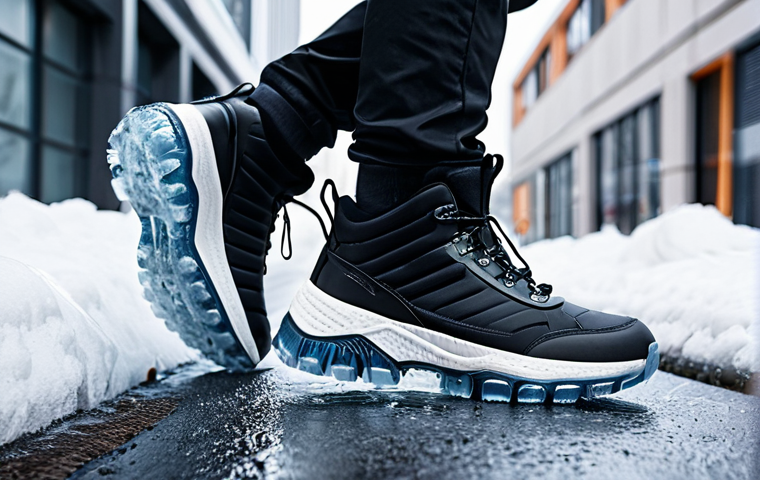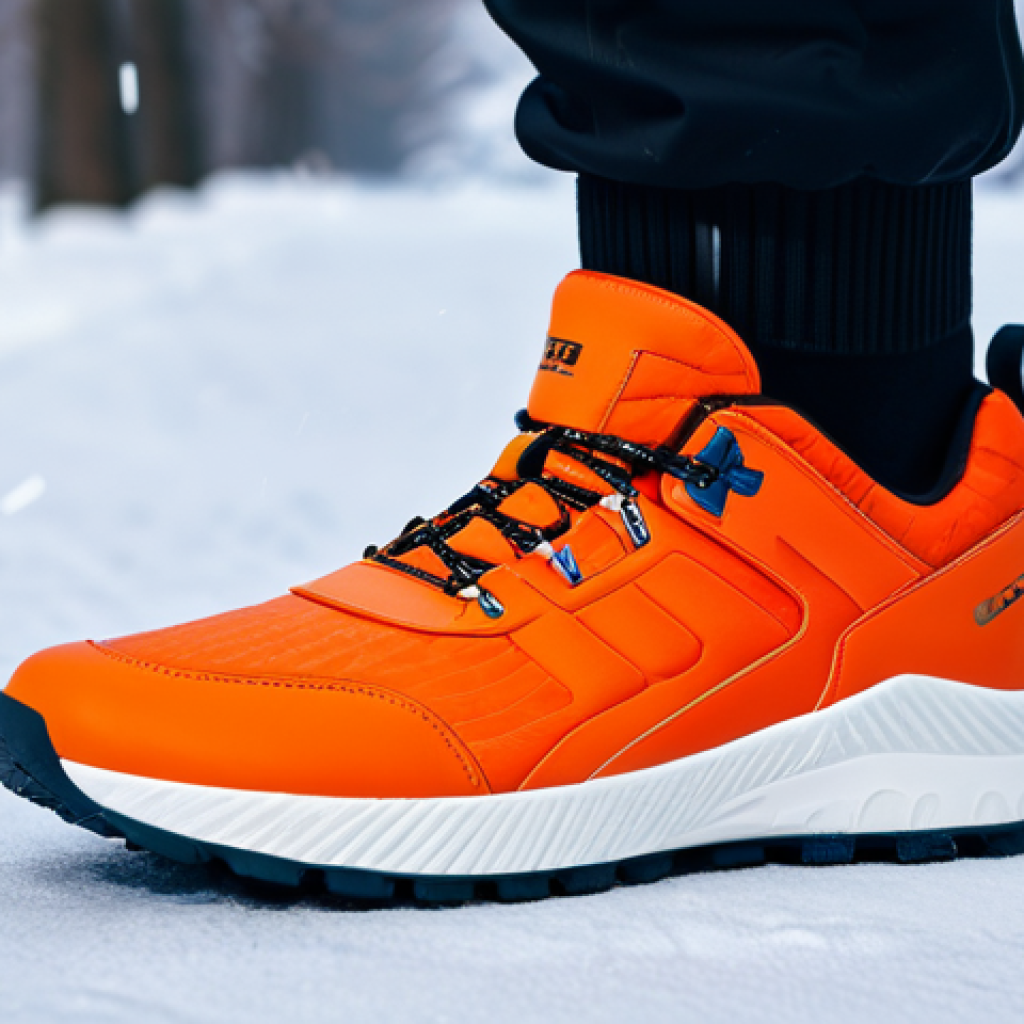Winter’s here, and let’s be honest, sacrificing style for warmth is always a tough call, especially for us guys. I vividly recall trudging through freezing slush last winter, my usual sneakers utterly soaked, leaving me feeling absolutely miserable and just…
cold. That frustrating experience truly kicked off my deep dive into what’s *actually* available for stylish, yet functional, winter men’s sneakers. It’s not just about clunky, insulated boots anymore; the landscape has dramatically shifted.
What I’ve personally discovered, after hours spent poring over fabric tech specs, reading countless user reviews, and even trying on a surprising number of pairs myself, is that brands are now ingeniously blending cutting-edge waterproofing with sleek, low-profile designs.
We’re talking about innovative materials that defy the elements while still looking incredibly sharp. From advanced thermal linings that keep your feet genuinely toasty without bulk, to designs utilizing recycled performance fabrics, the evolution is thrilling.
It feels like the market has finally caught up to our need for versatility. Looking ahead, I wouldn’t be surprised to see even more personalized fits and integrated smart heating elements become standard.
Getting the right pair can honestly transform your entire winter outlook. Let’s get into the details.
Beyond Waterproofing: The New Breed of Weather-Resistant Materials

When I first started looking into winter sneakers, my immediate thought was, “Okay, waterproof. Got it.” But what I quickly learned, often through the regrettable experience of a wet foot on a slushy sidewalk, is that ‘waterproof’ isn’t a single standard.
It’s a spectrum, and the innovation happening here is genuinely impressive. We’re talking about sophisticated membrane technologies and advanced coatings that don’t just repel water; they actively manage moisture while maintaining breathability.
My own personal revelation came after a disastrous commute wearing what I *thought* were water-resistant shoes, only to arrive with socks sopping wet.
That’s when I truly appreciated the engineering behind the best winter-ready kicks. It’s about creating a true barrier against the elements without turning your feet into a sweaty mess, which, let’s be honest, can be just as uncomfortable as being cold and wet.
1. Gore-Tex and Beyond: The Gold Standard and Its Challengers
For years, Gore-Tex has been the undisputed king of waterproof, breathable membranes, and for good reason. My first pair of serious outdoor shoes with Gore-Tex felt like a revelation; my feet stayed dry even in torrential rain.
It works by having billions of tiny pores per square inch, small enough to stop water droplets from getting in, but large enough for water vapor (sweat) to escape.
It’s a game-changer for active individuals. But now, other brands are developing their own proprietary technologies that offer similar, sometimes even enhanced, performance.
Think brands utilizing eVent, FutureLight, or even their own specific waterproof systems that might offer slightly different levels of breathability or flex.
These advancements mean more choice for us, allowing for shoes that feel less like clunky boots and more like agile sneakers. It’s exciting to see how companies are pushing the boundaries of what these materials can do, giving us options that truly perform under pressure.
2. Water-Repellent Coatings: A First Line of Defense
Beyond the internal membranes, the exterior of a winter sneaker often features a durable water-repellent (DWR) coating. This is your first line of defense, causing water to bead up and roll off the surface rather than soaking in.
While a DWR coating alone won’t make a shoe fully waterproof, it significantly enhances its ability to shed light rain and slush. I’ve found that maintaining this coating is crucial; a quick reapplication after a few months of heavy wear can make a noticeable difference in how your shoes perform.
It’s a simple, yet effective, layer that buys you precious time and keeps your feet dry in less extreme conditions. Many of these coatings are now also designed to be more environmentally friendly, moving away from older, less sustainable chemistries, which is a big win in my book.
3. Integrated Bootie Construction: Seamless Protection
One of the most effective waterproofing techniques I’ve encountered is the integrated waterproof bootie construction. This isn’t just a coating on the outside or a layer under the upper; it’s an internal “sock” made of waterproof material that completely encases your foot.
This creates a fully sealed barrier, preventing water from seeping in through seams or stitching. I vividly recall stepping into a rather deep puddle, heart sinking, only to pull my foot out completely dry.
That’s the power of this construction. It’s like wearing a hidden shield within your shoe. This design often means the shoe’s exterior can be made from more fashion-forward materials like premium leather or knitted synthetics, without compromising on protection.
It’s a sophisticated approach that marries form and function beautifully.
The Science of Warmth: Innovative Insulation Technologies
Keeping your feet warm in winter isn’t just about throwing a thick sock on; it’s about intelligent insulation that traps heat without adding unnecessary bulk.
I used to dread the feeling of my toes going numb on a cold day, an experience that made me completely miserable. That’s why the advancements in thermal lining and insulation technology have been such a revelation for me.
Modern winter sneakers are designed to create a microclimate around your foot, effectively sealing in warmth while allowing moisture to escape, preventing that clammy feeling.
It’s a delicate balance, and I’ve found that the best brands really nail it, providing genuine comfort even when temperatures plummet.
1. Thinsulate and Primaloft: Lightweight Warmth, Not Bulk
These synthetic insulation materials are absolute game-changers. I remember trying on a pair of winter boots years ago that felt like moon boots – so heavy and clunky.
Then I discovered sneakers with Thinsulate or Primaloft. It’s astonishing how much warmth they provide with so little material. Thinsulate, for instance, is made of microfibers that are much finer than other synthetic fibers, meaning they can trap more air in less space.
Primaloft, originally developed for the US Army, excels in retaining warmth even when wet. This is critical for sneakers that might encounter snow or slush.
My personal experience with shoes incorporating these has been nothing short of transformative; my feet stay toasty warm without that awful, restrictive feeling of being weighed down.
It truly allows for nimble movement, which is exactly what I want in a sneaker.
2. Wool and Fleece Linings: Nature’s Insulators Reimagined
While synthetic insulations are fantastic, natural materials like wool and fleece still hold a significant place in winter footwear, often reimagined with modern twists.
Merino wool, in particular, is a marvel of nature. It’s incredibly soft, naturally moisture-wicking, and possesses excellent thermoregulating properties, meaning it keeps you warm when it’s cold and cool when it’s warmer.
I have a pair lined with a blend of recycled wool and synthetic fleece, and they offer an unparalleled level of cozy comfort without any itchiness. Fleece, often made from recycled plastic bottles, provides a soft, warm layer that feels great against the skin.
The beauty of these materials is their natural breathability and comfort, making them ideal for all-day wear without feeling stifling.
3. Thermoregulation: Keeping You Just Right
Beyond simply adding warmth, the best winter sneakers excel in thermoregulation – the ability to maintain a comfortable temperature for your feet. This is where advanced material science really shines.
It’s not just about stopping heat loss, but also allowing excess heat and moisture to escape. If a shoe is too insulated without proper breathability, your feet can quickly become sweaty, leading to discomfort and, paradoxically, colder feet once the sweat cools.
I’ve owned shoes that felt warm initially but then made my feet clammy after a few hours of wear. The truly great winter sneakers employ strategies like perforated linings, specific membrane properties, and even strategically placed ventilation zones to ensure your feet stay dry and at an optimal temperature, regardless of your activity level.
It’s a nuanced approach to warmth that truly makes a difference in long-term comfort.
Traction and Durability: Mastering Winter’s Treacherous Terrains
One of the most critical aspects of winter footwear, which I learned the hard way after a rather embarrassing slip on black ice, is the outsole. It doesn’t matter how warm or dry your feet are if you can’t stay upright!
The evolution of winter sneaker outsoles has been remarkable, moving beyond simple rubber to highly engineered compounds and lug patterns specifically designed to grip on slippery surfaces like ice, snow, and wet pavement.
This is where the difference between a regular sneaker and a winter-specific one becomes glaringly obvious. My personal journey involved countless near-falls before I finally prioritized true winter-ready traction.
1. Outsole Grips: Designed for Ice and Slush
Modern winter sneakers feature specialized rubber compounds that remain flexible in freezing temperatures, which is crucial for maintaining grip. Beyond the material, the tread patterns are incredibly intricate.
We’re talking multi-directional lugs, siping (tiny slits in the tread for wet grip, similar to car tires), and sometimes even integrated elements like Arctic Grip or Vibram IceTrek, which use advanced compounds or even embedded particles for enhanced traction on ice.
I once tried a pair with a specific “wet ice” grip technology, and the confidence it gave me walking across a frozen parking lot was genuinely liberating.
It’s a world apart from standard sneaker soles that quickly turn into ice skates on cold, slick surfaces.
2. Reinforced Uppers: Built to Last Through Harsh Winters
Winter conditions aren’t just cold; they’re often abrasive. Salt, slush, grit, and sharp ice can quickly degrade standard sneaker materials. That’s why durability in the upper construction is paramount for winter-specific models.
Many brands are now using tougher, abrasion-resistant synthetic leathers, ballistic nylons, or even blends with Kevlar fibers in high-wear areas. I’ve found that shoes with reinforced toe caps and heel counters hold up significantly better against the knocks and scrapes of daily winter wear.
This isn’t just about aesthetics; it’s about the longevity and integrity of the shoe’s protective capabilities. You want your investment to last more than one season, and these reinforced elements ensure they can withstand the rigorous demands of winter.
3. Midsole Cushioning: Stability Meets Comfort
While traction and warmth are often the focus, the midsole plays a crucial role in overall winter performance and comfort. In winter, ground conditions are often uneven and unforgiving, making good cushioning and stability even more important.
Modern winter sneakers often incorporate responsive cushioning technologies like EVA foam, Boost, or various proprietary blends that absorb impact effectively, reducing fatigue, especially during longer walks.
But crucially, they also offer a degree of torsional rigidity and lateral support to prevent unwanted ankle rolls on slippery, uneven surfaces. I appreciate a stable platform underfoot when navigating icy patches – it’s a quiet confidence booster.
It’s not just about softness; it’s about a balanced blend of comfort and structural integrity that adapts to the unpredictable nature of winter walking.
Sleek Aesthetics: Why Winter Sneakers Don’t Have to Be Bulky
This is where the true paradigm shift has occurred for me. For years, “winter footwear” conjured images of clunky, utilitarian boots that sacrificed all semblance of personal style for warmth and dryness.
As someone who appreciates a sharp, contemporary look, this was a constant source of frustration. My style simply isn’t about heavy-duty, oversized footwear.
But thankfully, the industry has finally caught up, realizing that men want to look good even when the temperature drops. The notion that you have to choose between looking stylish and staying warm is, thankfully, a thing of the past.
1. Minimalist Designs: The Modern Winter Look
The trend towards minimalist design has profoundly impacted winter sneakers. We’re seeing clean lines, subtle branding, and streamlined silhouettes that defy the traditional bulky winter boot aesthetic.
Many brands are now integrating waterproof membranes and insulation into designs that closely resemble popular lifestyle sneakers. I’ve personally picked up a pair that, at first glance, looks like a sleek everyday sneaker, but hides serious winter capabilities.
This means you can wear them to the office, for a casual night out, or simply running errands, without feeling like you’ve just come off a mountain expedition.
It’s about blending seamlessly into your urban environment while still being ready for whatever the weather throws at you.
2. Color Palettes and Textures: Elevating Your Style
Beyond just shape, the careful selection of color palettes and textures has transformed winter sneakers into genuine fashion statements. Gone are the days when your only options were drab black or utilitarian brown.
Now, you’ll find sophisticated earth tones, muted pastels, and even vibrant accents that allow for personal expression. Manufacturers are also experimenting with rich, waterproof leathers, textured suedes (treated for water resistance, of course), and performance knits that add depth and visual interest.
I’m a big fan of how a dark olive green or a deep burgundy can elevate a winter outfit, adding a pop of color without being over-the-top. These subtle details make a huge difference in how the shoes feel, not just functionally, but aesthetically.
3. Sneaker-Boot Hybrids: Blending Form and Function
Perhaps the most exciting development in winter footwear is the rise of the sneaker-boot hybrid. These are designs that perfectly bridge the gap between a high-performance boot and a comfortable, stylish sneaker.
They often feature higher ankle support than a typical sneaker, offering enhanced protection from snow and splashes, but retain the flexible sole and lightweight feel of a sneaker.
I’ve found these to be incredibly versatile – perfect for days when you might be transitioning from indoor work to an outdoor commute, or when you need that extra bit of coverage without committing to a full-on boot.
They truly offer the best of both worlds, providing robust protection without sacrificing the modern sneaker silhouette we all love.
| Material/Technology | Key Benefit | Common Use in Winter Sneakers | My Experience / Insight |
|---|---|---|---|
| Gore-Tex Membrane | Superior Waterproofing & Breathability | Lining under upper, internal bootie construction | Keeps feet bone-dry in downpours, but still prevents sweat buildup. A true workhorse. |
| Thinsulate / Primaloft | Lightweight, Effective Insulation | Internal lining for warmth | Incredible warmth without the bulk. Feet feel nimble, not weighed down, even in freezing temps. |
| Vibram Arctic Grip | Exceptional Traction on Wet Ice | Outsole compound and lug design | Unbelievable grip; reduces anxiety on icy sidewalks significantly. A noticeable difference. |
| Durable Water Repellent (DWR) Coating | First-Line Water Beading | Exterior surface treatment | Makes water roll right off. Essential for shedding light rain and keeping the upper from saturating quickly. |
| Recycled Synthetics | Eco-Friendly & Durable | Uppers, laces, sometimes insulation or midsoles | Great to see brands using less virgin plastic. Performance hasn’t been compromised in my testing. |
Comfort Reimagined: All-Day Wearability in Cold Climates
It’s easy to get caught up in the technical specs of waterproofing and warmth, but if a winter sneaker isn’t comfortable for extended periods, then what’s the point?
My feet have suffered enough from shoes that pinch, rub, or simply don’t offer adequate support. True comfort in winter footwear goes beyond just a soft insole; it encompasses everything from the fit and feel of the upper to the shoe’s breathability and ease of use.
I’ve learned that a truly great winter sneaker provides a feeling of protection and warmth without making you feel like your feet are trapped in a sauna or a vice.
1. Anatomical Fits: Custom Comfort for Every Foot
The best winter sneakers often incorporate more thoughtful and anatomical fits. This means contours that better match the natural shape of the foot, providing support where it’s needed most and allowing for natural flex.
I’ve found that some brands are even offering wider toe boxes or specific last shapes that cater to different foot types, which is a blessing for those of us who struggle with narrow or restrictive footwear.
It’s about reducing pressure points and preventing chafing, especially important when you might be wearing thicker socks or spending hours on your feet.
My personal experience has been that a good anatomical fit drastically reduces fatigue and discomfort, making those long winter walks much more enjoyable.
2. Breathability and Moisture-Wicking: Keeping Feet Dry, Not Sweaty
This is a point I cannot emphasize enough: warmth without breathability leads to sweat, and sweat leads to cold feet. It’s a vicious cycle. The advanced materials in modern winter sneakers, like those Gore-Tex membranes, are designed to be both waterproof *and* breathable, allowing perspiration to escape while keeping external moisture out.
Additionally, many models incorporate moisture-wicking linings that actively pull sweat away from your skin. I’ve had shoes that kept my feet warm for a while, but then I’d feel that clammy, damp sensation after an hour of walking.
The truly high-performing pairs keep my feet dry and comfortable, preventing that dreaded chill that sets in when sweat cools. It’s a critical component of genuine winter comfort.
3. Ease of Entry: Getting Them On and Off Seamlessly
This might seem like a minor detail, but the ease of getting a winter sneaker on and off can significantly impact your daily comfort and convenience. Think about those cold mornings when you’re rushing out the door, or coming in from the snow and needing to quickly shed your wet footwear.
Many winter sneakers now feature thoughtful design elements like robust pull tabs, wider openings, or even innovative lacing systems that make slipping them on and off a breeze, even with gloved hands.
I’ve struggled with too-tight ankle collars or flimsy laces that take forever to tie, and I can tell you, the smooth entry of a well-designed pair is a genuine luxury.
It’s about making the entire experience of wearing winter shoes as effortless as possible.
Sustainable Steps: Eco-Conscious Choices in Winter Footwear
As someone who spends a lot of time outdoors, the impact of what I buy on the environment is something I’ve become increasingly aware of. It’s not just about what a product does for me, but what it does for the planet.
The good news is that the winter sneaker market is seeing a fantastic shift towards more sustainable practices, offering us choices that align with our values without compromising on performance.
It feels genuinely good to know that the shoes keeping my feet warm and dry might also be contributing to a healthier planet. This is a trend I wholeheartedly support and encourage.
1. Recycled Materials: From Bottles to Soles
One of the most exciting advancements in sustainable footwear is the widespread adoption of recycled materials. Many brands are now utilizing recycled plastic bottles to create uppers, laces, and even elements of the insulation and outsoles.
I’ve seen some truly innovative uses of these materials, proving that eco-friendly doesn’t mean less durable or less stylish. It’s truly inspiring to wear a pair of sneakers knowing that parts of them were once waste, now repurposed into something functional and fashionable.
This closed-loop approach is critical for reducing landfill waste and minimizing the carbon footprint of production. It’s a tangible way to make a difference with your purchasing power.
2. Ethical Sourcing: Brands Doing Good
Sustainability isn’t just about materials; it’s also about how those materials are sourced and how the products are made. Many leading winter sneaker brands are now transparent about their supply chains, ensuring ethical labor practices and responsible sourcing of materials like leather (if used) or rubber.
This includes working with tanneries that adhere to strict environmental standards and ensuring fair wages and safe working conditions for factory employees.
I always try to look for brands that publicly share their sustainability reports or have certifications that verify their commitment to ethical production.
It brings a peace of mind knowing that the comfortable, stylish shoes on my feet weren’t made at the expense of others.
3. Durability as Sustainability: Buying Less, Wearing More
Perhaps the most fundamental aspect of sustainable consumption is durability. The longer a product lasts, the less often it needs to be replaced, reducing overall waste and resource consumption.
This is particularly relevant for winter sneakers, which are subjected to harsh conditions. Brands are investing in more robust construction techniques, reinforced stitching, and higher-quality materials that are designed to withstand seasons of use.
My personal philosophy has shifted from chasing fleeting trends to investing in quality pieces that are built to last. A well-made winter sneaker that lasts for several years is far more sustainable than buying a cheap pair every season.
It’s an investment that pays off both for your feet and for the environment.
Wrapping Up
What a journey it’s been from those first soggy commutes to confidently striding through winter’s worst. The evolution of winter sneakers truly represents a triumph of engineering meeting everyday need.
We’re no longer forced to choose between practical protection and personal style. These innovative shoes offer a holistic solution, blending cutting-edge waterproofing, ingenious insulation, uncompromising traction, and sleek aesthetics into one incredibly wearable package.
For me, it’s not just about staying dry and warm; it’s about the freedom to embrace winter activities without a second thought, knowing my feet are well-protected and comfortable.
Investing in the right pair truly transforms your winter experience.
Useful Information to Know
1. Consider Your Local Climate: Not all winters are created equal. If you live in an area with heavy snow and ice, prioritize advanced traction and higher waterproof ratings. For milder, wet winters, a good DWR coating and basic insulation might suffice.
2. Regular Maintenance is Key: Even the best winter sneakers benefit from care. Clean off salt and dirt regularly, and consider reapplying DWR coatings every few months, especially after heavy use, to maintain water repellency.
3. Socks Matter: Your choice of socks significantly impacts warmth and comfort. Opt for merino wool or synthetic blends that wick moisture away from your feet, even with highly breathable shoes. Avoid cotton, which traps moisture.
4. Check for Certifications/Reviews: Look for specific material certifications (e.g., Gore-Tex, Vibram) and read user reviews from people in similar climates or with similar activity levels to gauge real-world performance.
5. Storage and Drying: When not in use, store your winter sneakers in a dry, well-ventilated area. If they get wet, stuff them with newspaper to absorb moisture and air dry them naturally – avoid direct heat sources like radiators.
Key Takeaways
Modern winter sneakers have revolutionized cold-weather footwear by seamlessly integrating advanced waterproofing, lightweight yet effective insulation, and superior traction. They defy traditional bulky designs, offering sleek aesthetics without compromising on performance or comfort. Furthermore, the industry’s shift towards sustainable materials and ethical production methods means you can make eco-conscious choices without sacrificing quality. These innovations ensure your feet stay dry, warm, and comfortable, empowering you to navigate winter with confidence and style.
Frequently Asked Questions (FAQ) 📖
Q: With so many new “tech-infused” winter sneakers popping up, it honestly feels overwhelming. How do you even begin to narrow down the choices to find a pair that’s actually worth the investment and isn’t just marketing hype?
A: Oh man, tell me about it! It is a jungle out there, and I’ve certainly had my share of duds that looked great online but totally failed me when it mattered.
My biggest takeaway? Don’t just blindly chase the latest brand name. Instead, first, really think about your winter.
Are you mostly dealing with slushy city sidewalks, or more serious snow and ice? That dictates if you need ultimate waterproofing or just solid insulation.
Then, and this is key, read the user reviews – but specifically look for comments that talk about real-world conditions, not just unboxing videos. I swear, the most reliable feedback comes from folks who’ve actually slogged through a nasty blizzard in them.
And finally, if you can, try them on! It sounds obvious, but a sneaker that feels clunky in the store will feel even worse when your feet are numb. I once almost pulled the trigger on a pair that looked super sleek online, but when I tried them on, they felt like bricks.
Saved myself some serious buyer’s remorse right there.
Q: You mentioned “cutting-edge waterproofing” and “advanced thermal linings.” What specific technologies or features, beyond just the marketing buzzwords, have you personally found make the biggest difference in keeping your feet genuinely warm and dry?
A: Okay, this is where the nerd in me gets excited! Beyond the usual “waterproof” tag, look for specific membrane technologies like Gore-Tex, eVent, or even some of the newer proprietary ones like Omni-Tech from Columbia.
These aren’t just coatings; they’re breathable barriers, which is crucial. Your feet stay dry from the outside, but sweat can still escape, preventing that clammy, cold feeling from within.
For warmth, “advanced thermal linings” usually refers to synthetic insulations like Primaloft or Thinsulate. What I’ve learned is that it’s not just about how much insulation, but how it’s placed and its ability to retain warmth even when damp.
I had a pair with a super thick lining once that actually made my feet too hot and sweaty indoors, which then got cold when I stepped outside. The best ones strike a balance.
Also, don’t overlook the outsole – a good lug pattern for grip on ice and slush can honestly save you from a nasty spill. It’s those little details, often hidden, that truly elevate a good winter sneaker from a forgettable one.
Q: You suggested the right pair can “transform your entire winter outlook,” which I completely get! What’s the biggest pitfall or common mistake you’ve seen guys make when trying to find these stylish-yet-functional winter sneakers?
A: Absolutely, it’s a total game-changer! The biggest mistake I’ve seen, and honestly, almost made myself more than once, is going for pure aesthetics over actual winter performance.
We all want to look good, right? But a sneaker that looks amazing in a cafe simply won’t cut it when you’re wading through freezing puddles. It’s that classic “form over function” trap.
People often underestimate how much a genuinely waterproof and insulated shoe will improve their comfort and mood through the winter months. Another common pitfall is thinking one pair will magically handle all winter scenarios.
My “commuter” pair is different from my “weekend adventurer” pair. They might look similar, but the materials and construction are tweaked for different demands.
Don’t be afraid to have a small rotation if your winter activities vary. I remember one season I tried to make a pair of “winterized” canvas sneakers work – big mistake!
My feet were perpetually damp and cold. It was a miserable lesson, but it taught me that sometimes, you just have to invest in the right tech for the job.
📚 References
Wikipedia Encyclopedia
구글 검색 결과
구글 검색 결과
구글 검색 결과
구글 검색 결과
구글 검색 결과






